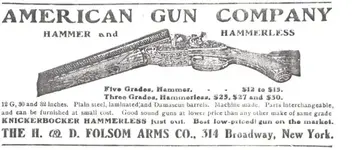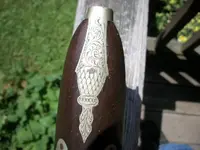strick
Full Member
- Joined
- Feb 28, 2005
- Messages
- 203
- Reaction score
- 138
- Golden Thread
- 0
- Location
- SF Bay Area
- Detector(s) used
- Embarrassed to tell
- Primary Interest:
- All Treasure Hunting
It's a ramrod guide from a Belgian made double barrel shotgun and likely dates to the 1840's. look at the pic I posted, and the link. The rust only shows that the screw or tack was still in it when it went in the ground. The rest of the gun could be nearby, but the rust spot alone is no guarantee.
Promise me you won't get mad? LOL... It is not from that gun, by any stretch. Zoom the Belgian pic, and not only the shape is more elaborate, look at the intense, well detailed engraving on it. It appears to have crosshatch or herringbone pattern inset into the main engraving. Something expected on a later, fancy, gents/hunting gun.
My point about engraving and the outline of the side spikes is, that the style of those must be considered, as well as the basic shapes involved, to get a date era or quality of the object
edit: on the rust stain residue. I hope you can see what I mean on the underside remains; Looking at the outside where the screwhead would be, there is a smaller round spot like you would expect from a head. You can even guess the size of the head. IMO
However the hidden side residue spread way out, like it was still against the wood.

 I was just in a bit of a hurry last night and that came out a bit shorter than I had intended..... The pic and link I posted is just for reference, to show the basic shape of the piece and how it fit to the stock. Not to say that it was the exact same gun. Just like today, there was wide range in price on these guns, and they went from plain to really fancy. Differences in engraving can be chalked up to different levels of pretty furniture on the various guns. They were hand finished, so really no two are going to be exactly alike.
I was just in a bit of a hurry last night and that came out a bit shorter than I had intended..... The pic and link I posted is just for reference, to show the basic shape of the piece and how it fit to the stock. Not to say that it was the exact same gun. Just like today, there was wide range in price on these guns, and they went from plain to really fancy. Differences in engraving can be chalked up to different levels of pretty furniture on the various guns. They were hand finished, so really no two are going to be exactly alike. 


I agree there would be a difference in different price levels.. Differences in engraving can be chalked up to different levels of pretty furniture on the various guns. They were hand finished, so really no two are going to be exactly alike.
EDIT : I should add, one reason I'm sure it's going to be from a mid 1800's percussion gun is where it was found, being a Chinese mining camp in California tells me it's not going to be too much older than the gold rush era. Also while there certainly are older double barrel flint lock guns, they were very expensive, and not the kind of thing you'd expect to find in a camp, and really by the time California was seeing mining camps they would have been considered obsolete and it's really unlikely that anyone would be carrying one around.


is that a rivet in the middle going thru a hole?
marion
NOLA_KEN - I am definitely not a firearms person at all, I just dig the heck out of them. My question to you is why is the screw on the first ram rod guide I showed on the under side where the stock would be? The hole does not go all the way through. Shouldn't it come from the other side? I did find another one where the screw has been pulled back and would go through and into the stock.
Also, I would like to point out that I have hunted numerous GR camps in Northern California and most were worked before the Chinese worked them. Myself and my circle of friends have found numerous relics and coins that pre-date the GR era. Who knows what was brought in from the East coast or from around the World! We know there were many many immigrants from all nationalities coming to California then. I have even found a Great Coat button in one of those camps. That button and the bust coins we find attest to what guys held onto for a long time as well as their firearms that were passed down from generation to generation.
IM

